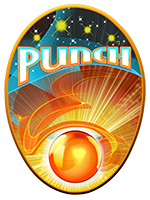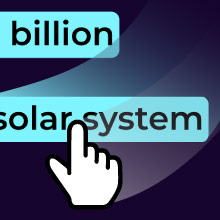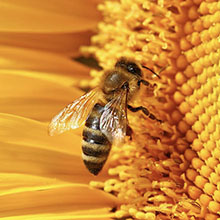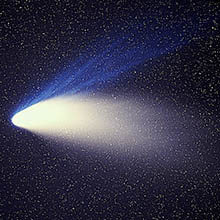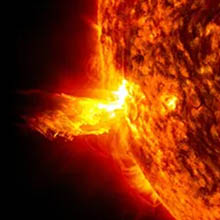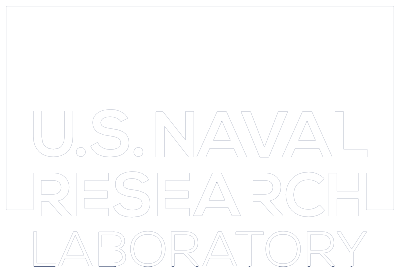Congratulations! You got them all right!

What is one reason Earth’s magnetic field is so important to
life? ● What is the name of
at least one NASA mission important to the study of the solar wind and our heliosphere?
Click (or touch) anywhere to go back and review or screen capture your work.

 #4. SOLAR WIND
and the HELIOSPHERE
#4. SOLAR WIND
and the HELIOSPHERE
Every second tons of material speeds away from the Sun in all directions. This so-called “solar wind” creates a “bubble” in space that surrounds the whole solar system.
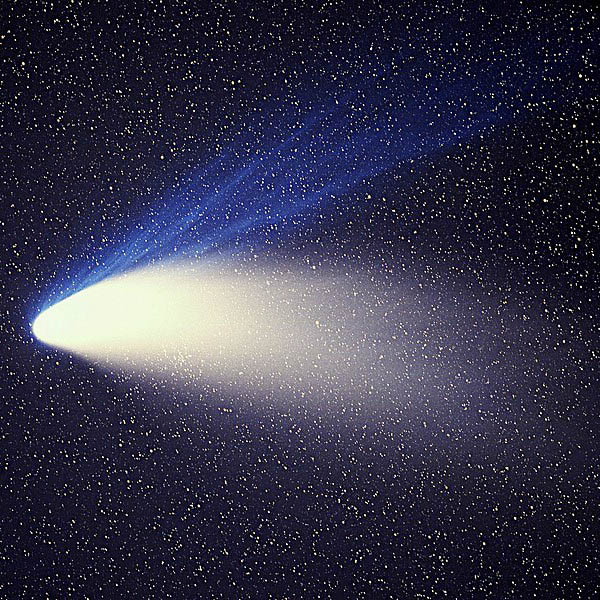
Image of Comet Hale-Bopp and its tail. Observations of comets (whose tails extend away from the Sun) first led scientists to suspect that there was a continuous outward flow of stuff from the Sun that we now call the “solar wind.” Comet tails are made of tiny pieces of the the comet that are removed by the solar wind. The tail points away from the Sun whether the comet is headed toward or away from the Sun.
Image credit: E. Kolmhofer, H. Raab; Johannes-Kepler-Observatory, Linz, Austria
Drag-and-drop fill-in-the-blanks
FITB #4. Challenge Level: High. Word count: 386.
# Blanks: 16. Prerequisites: #1 (Where is
the Sun?).
- DRAG & DROP the words into the spaces in the paragraph below to FILL-IN-THE-BLANKS. NOTE: The word will only drop successfully when the cursor tip (or your fingertip on mobile devices) is within the light-colored box above the blank which will turn yellow when the word is properly positioned.
- TO UNDO YOUR CHOICE click on the blue circle next to the dropped word.
solar wind
heliosphere
planets
inner
shield
particles
protect
Voyager
mythology
tons
the 1970s
comets
corona
Pluto
spacecraft
heliophysicists
The Sun gives off more than just light. It also sends out fast bits of material called “charged
.”
Every second, more than 300,000
of this material flows out in all directions from the Sun. We call this outflow the
“
,”
even though it is very different from any wind on Earth. The solar wind impacts everything in the Solar System, including all of the
.
Earth’s magnetic field acts like a
that deflects the solar wind around our planet, and this helps to
life on our home world.
Observations of
(whose long tails extend away from the Sun) first led scientists to suspect that there was a continuous outward flow of stuff from the Sun.
In the early 1960s, a young scientist named Marcia (MAR-shah) Neugebauer (NOY-geh-baa-wur) first measured the solar wind near Venus using an
instrument that was carried on a NASA
called Mariner 2. This was the first successful mission to another planet.
The solar wind “blows” a giant, bubble-like shape in space we call the
.
The first part of this word relates to the Sun god “Helios” from Greek
.
“Sphere” means an area of activity or interest, like the atmosphere or biosphere. So “heliosphere” means the area of outer space affected
by the Sun’s activity. The heliosphere extends outward from the Sun more than two times farther than the orbit of the dwarf planet
!
Scientists called
are still debating the shape of this “bubble” around our Solar System, and how it changes as the Sun’s activity changes.
While some NASA missions study the nature of the entire heliosphere, the NASA PUNCH mission studies only the solar wind of the
heliosphere between the Sun and Earth. The NASA Parker Solar Probe mission flies really close to the Sun, just “touching” the solar
,
which is the outer part of the Sun where the solar wind begins.
Only three human-made objects have travelled beyond our heliosphere. All three are NASA spacecraft called Pioneer 10,
1 and Voyager 2. They all launched in
.
Decades later they left the region of space influenced by the Sun, and now they travel through the vast space between the stars!
Check Your Answers
More Fill-In-the-Blank games
Please contact PUNCH Outreach with questions, ideas, or other comments about this product.
